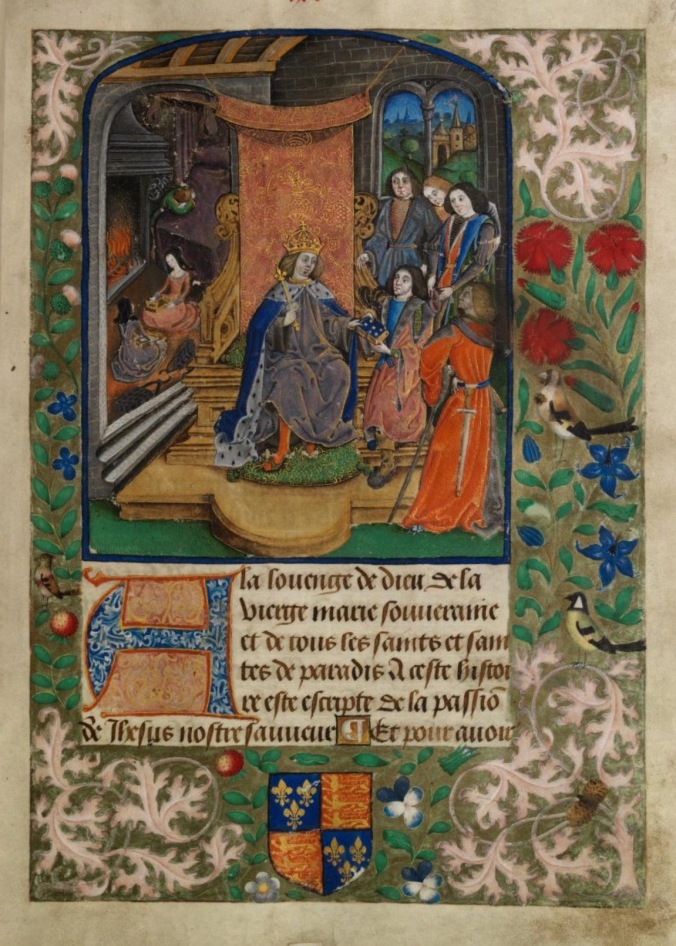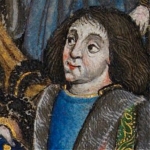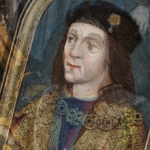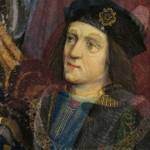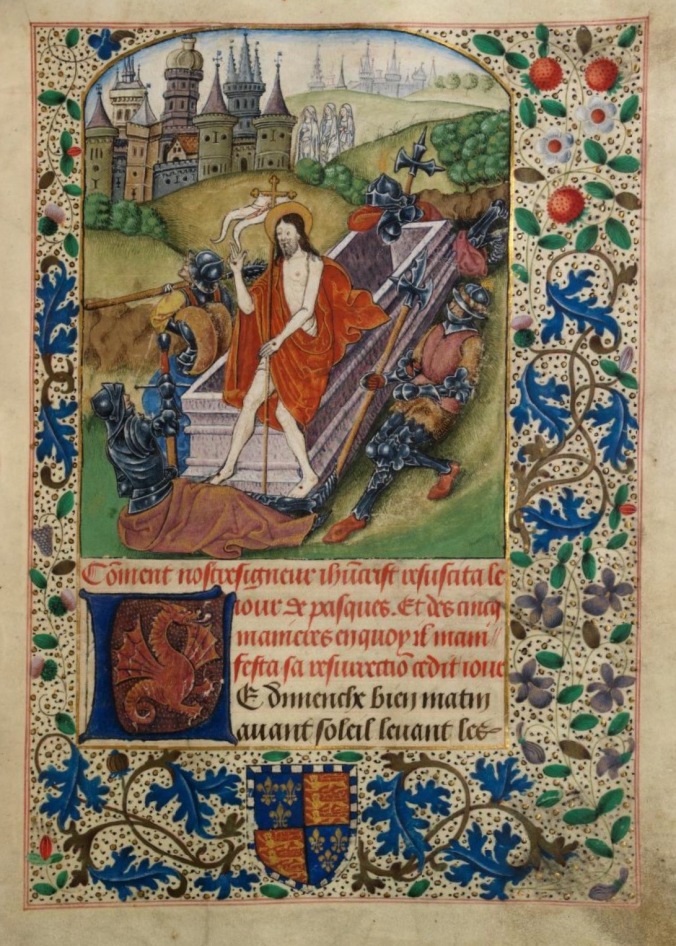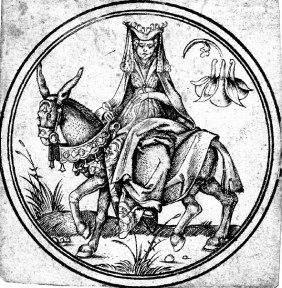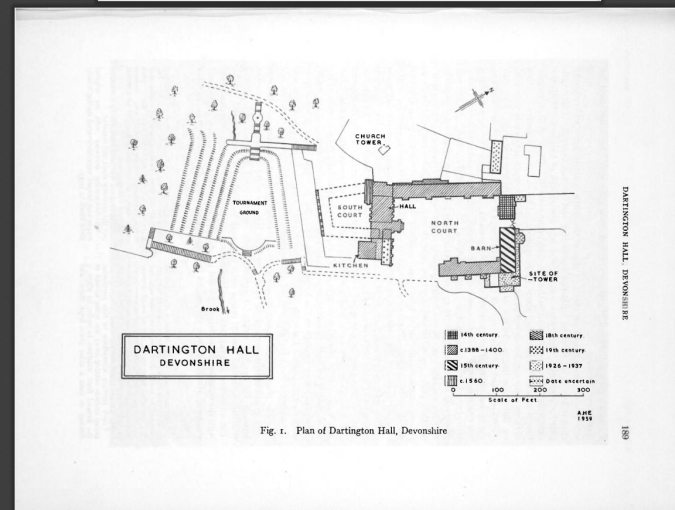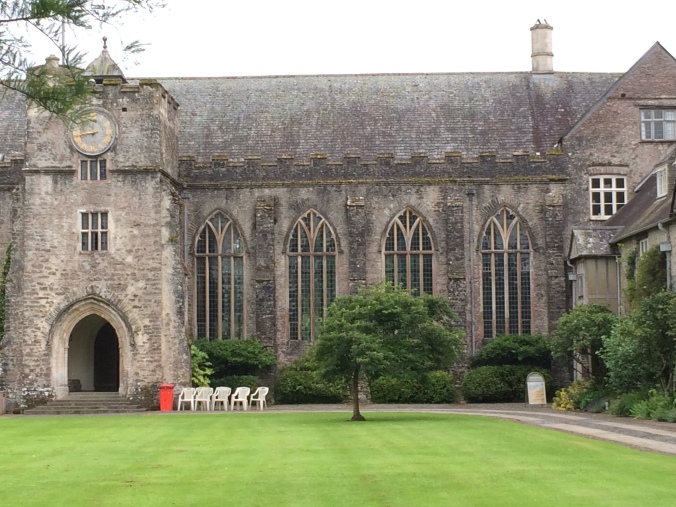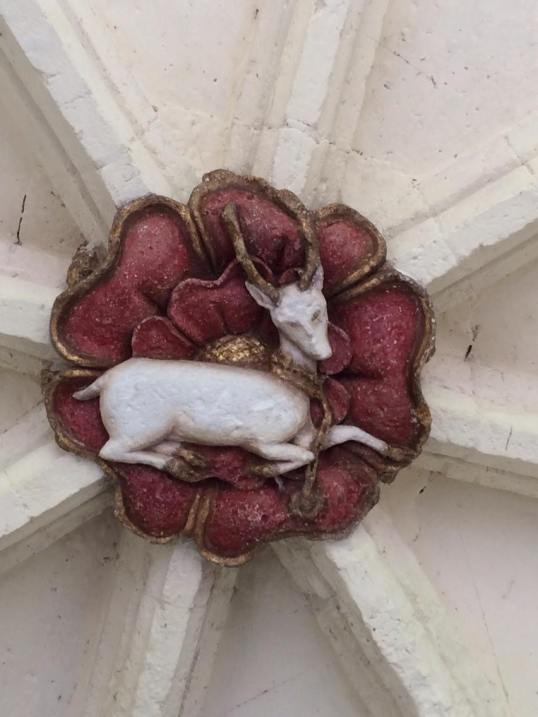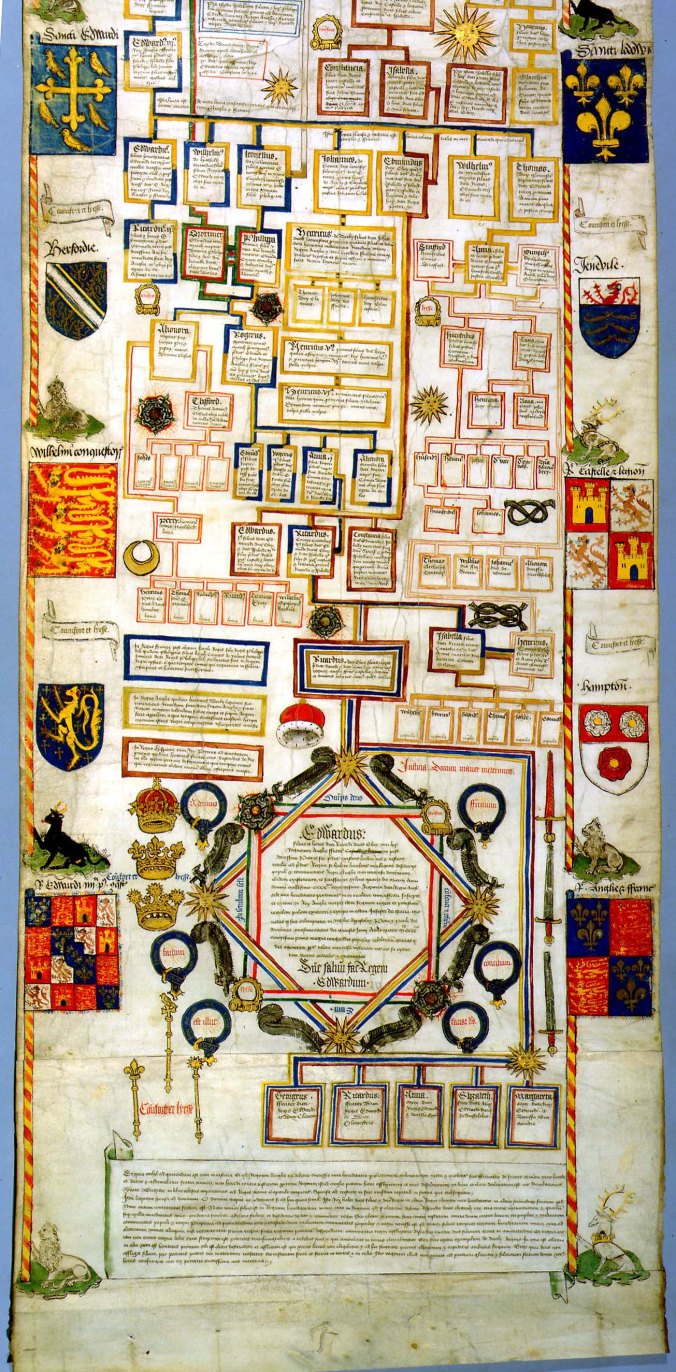In 1921, a late medieval manuscript was donated to the National Library of Wales. It was a “passional”, a book recounting the sufferings of saints and martyrs, and contained two texts in medieval French: “La Passion de Nostre Seigneur” (The Passion of Our Lord), an account of the Passion of Christ, and “Le miroir de la mort” (The mirror of death), a religious poem by the Burgundian chronicler Georges Chastellain. The book had once been owned by Lady Joan Guildford (c. 1463-1538), nee Vaux, who served in the household of Elizabeth of York as governess to the Princesses Mary and Margaret Tudor, but it didn’t receive any special attention until 2012 when it was digitised to make it available on the internet.
When Dr Maredudd ap Huw, the library’s manuscripts librarian, examined the first miniature in the book, he realised that it appeared to show the family of Henry VII, including the future Henry VIII, mourning the death of his Queen, Elizabeth of York (1466-1503). Young Henry, who is shown slumped over his mother’s empty bed, was 11 years old at the time of her death, making this the earliest known depiction of him and certainly the most vulnerable. Also present are his sisters Margaret and Mary, dressed in mourning black, while the sovereign in the centre of the miniature appears to be an idealised version of their father, Henry VII. The bottom of the page bears the royal arms of England.
Dr ap Huw’s discovery catapulted the Vaux Passional to fame, but while the figures on the left of the miniature are now tentatively identified, the others remain shrouded in mystery. Most mysterious of all is the man at the centre who is handing a book to the King, so much so that Dr ap Huw has appealed to fellow historians and even members of the public for suggestions who he could be. Unfortunately, the response has been muted: apparently I was the only member of the public who contacted him. This post is a summary of my suggestions and replies I received from him and other experts.
Presentation Miniature Or Not?
At first glance, the scene appears to be a typical “presentation miniature”, a type of illustration which shows the author of a book – in this case the passional – or the person who commissioned the book presenting it to his patron – in this case, Henry VII. It was therefore initially assumed that the book had been owned by Henry before passing into Lady Guildford’s possession. As for the mystery man, since both texts contained in the book had been published before, he can’t be the author. He would therefore have to be the person who commissioned the book, but this is where it gets mysterious.
He is unlikely to be Sir Richard Guildford since he has been tentatively identified by Dr ap Huw as the man in the foreground holding the white wand of the office of Comptroller of the Household. The book bears an inscription by Lady Guildford’s son, Sir Henry Guildford, but he was only 14 years old at the time of Queen Elizabeth’s death and her brother was in France where he served as Lieutenant of Guînes. Dr ap Huw had hoped that the coats of arms on other pages of the manuscript would help to identify the mystery man, but they were found to point to Lady Guildford’s maternal ancestors, except those on the page depicting Christ’s resurrection, which belong to the family of Henry VII’s mother, the Beauforts. This discovery led Dr ap Huw to reconsider his original interpretation that the book had been commissioned for Henry VII and allow for the possibility that it had actually been intended for Lady Guildford. However, in that case the scene can’t be a presentation miniature as the recipient of the book is clearly a male monarch.
There are other clues supporting this conclusion. In presentation miniatures the person presenting the book is usually shown kneeling, but the mystery man is standing. The composition places him on roughly the same floor level as the king and his facial expression and body language are relaxed and confident – he looks more like an equal than a subject paying tribute to his sovereign. And the book in the picture is blue while the passional is bound in red velvet which, according to the library’s website, is the original binding. So if the book was commissioned for Lady Guildford then we should take a closer look at her and her family.
Who Was Joan Guildford?
The Guildfords are usually considered pillars of the Tudor regime. Lady Guildford was the daughter of William Vaux, who died fighting for Henry VI and Margaret of Anjou at Tewkesbury. Her mother Katherine Vaux, nee Peniston, served Queen Margaret as lady-in-waiting and was so loyal to her mistress that she is said to have shared her imprisonment and exile. Young Joan and her brother Nicholas were brought up in the household of Henry VII’s mother, Margaret Beaufort, and Joan went on to become her lady-in-waiting. Nicholas is thought to have fought for Henry at Bosworth as he later did at Blackheath and Stoke, for which he was knighted. Lady Guildford’s husband, Sir Richard Guildford, was the son of Sir John Guildford, who had been Comptroller of the Household to Edward IV, but lost his position when Richard III became King. Both father and son took part in Buckingham’s rebellion and when it was quashed Sir Richard joined Henry in exile in Brittany. Like his brother-in-law, he is thought to have fought for him at Bosworth.
What’s less well known is that Lady Guildford’s Yorkist links went beyond her service in Elizabeth of York’s household and her father-in-law’s service to Edward IV. Despite her devotion to Margaret of Anjou, her mother had received an annuity of 20 marks from Richard III, the same amount she would later receive from Henry VIII. Her brother’s first wife was Elizabeth FitzHugh, daughter of Sir Henry FitzHugh and Alice Neville, niece of Cecily Neville, duchess of York and aunt to Anne Neville, Richard’s Queen. Both Elizabeth and her mother had served Queen Anne as ladies-in-waiting and her sister Anne FitzHugh was the wife of Francis Lovell, Richard’s friend and one of the leaders, together with Richard’s nephew John de la Pole, of the Lambert Simnel rebellion against Henry VII. Most strikingly, in 1504 Sir Richard Guildford was accused by one of Henry’s spies of supporting the Yorkist pretender Edmund de la Pole, John’s brother, whose household he had been trying to infiltrate. Meanwhile Lady Guildford’s brother, when asked about the possibility of de la Pole succeeding Henry, reportedly commented that he “should be sure to make his peace how so ever the world turn.” In 1505, Sir Richard was arrested and sent to prison, allegedly for not keeping proper accounts when Master of the Ordnance, and was only pardoned the following year. He died a few months later while on pilgrimage to the Holy Land.
This doesn’t necessarily mean that Lady Guildford’s loyalties were divided. Indeed, after her husband’s death she re-entered Margaret Beaufort’s household and in 1514 when Princess Mary married King Louis XII she accompanied her former charge to France. However, her immediate family certainly included people who had been part of the Yorkist King Richard III’s inner circle and had known him personally. I’ll come back to this later.
Who Is The Mystery Man?
Unlikely as it may seem, he looks remarkably like . . . Richard III. The hair style, texture and colour as well as facial features – prominent chin, down turned corners of the mouth and furrowed brow – are similar to Richard’s portraits from the Tudor period. These were created based on an established pattern and while book illustrations aren’t usually faithful portraits the miniature broadly follows it: allowing for the cartoonish style, the 3/4 perspective, facial features and even the frown line between his eye brows line up remarkably well. The position of his hands – holding a book rather than fiddling with his ring – and his facial expression – smiling instead of looking stern or sinister – are different, but he certainly looks more like Richard III than the idealised sovereign looks like Henry VII. Finally, the coat of arms on this page of the manuscript was used by both Henry and Richard: the royal arms of England.
The mystery man 1) superimposed on the Society of Antiquaries portrait 2), the Royal Collection portrait 3) and the NPG portrait 4)
So could this be Richard? According to the Richard III Society, there’s no precedent for depictions of a dead king handing a present to his living political enemy. This may be true of presentation miniatures, but a very similar scene is described in the epitaph of the alabaster tomb that Henry placed on Richard’s grave in 1494, almost 10 years after Bosworth. The exact wording of the epitaph as it appeared on the tomb is unclear as several different versions of it exist and all of them appear to have transcription errors. The Guildhall version, which has survived in Sir George Buck’s 17th century biography “THE HISTORY OF KING RICHARD THE THIRD”, reads:
”I, here, whom the earth encloses under various coloured marble,
Was justly called Richard the Third.
I was Protector of my country, an uncle ruling on behalf of his nephew.
I held the British kingdoms in trust, although they were disunited.
Then for just sixty days less two,
And Two summers, I held my sceptres.
Fighting bravely in war, deserted by the English,
I succumbed to you, King Henry VII.
But you yourself, piously, at your expense, thus honoured my bones
And caused a former king to be revered with the honour of a king
When in twice five years less four
Three hundred five-year periods of our salvation had passed.
And eleven days before the Kalends of September
I surrendered to the red rose the power it desired.
Whoever you are, pray for my offences,
That my punishment may be lessened by your prayers.” 1
The Wriothesley-Hawling-Sandford version of the epitaph is more critical of Richard2 but describes the transfer of royal power from him to Henry in equally amicable terms. Is this why the book in the miniature doesn’t look like the passional – because it isn’t a physical book, but Richard’s present to Henry?
The Red Rose Of Beaufort?
The surrender of power to the “red rose” who had “desired” it, as described in the epitaph, deserves closer scrutiny. Firstly, it’s an admission that Richard “surrendered” his power not of his own volition, but because someone else desired it – or, according to the Wriothesley-Hawling-Sandford version, was owed it as a right. But who is this red rose? Both John Ashdown-Hill and Thomas Penn have pointed out that, while the Plantagenets had been using rose emblems as far back as Eleanor of Provence, wife of Henry III, these tended to be gold or indiscriminate in colour and were often subordinate to other heraldic badges, such as Henry VI’s antelope. Until 1485 the only royal rose emblem was the white rose of York as used by Edward IV and Richard III.
When Henry VII married Elizabeth of York, he introduced the red-and-white Tudor rose, supposedly a fusion of his red rose of Lancaster, which however hadn’t really existed before, and her white rose of York. Henry’s instructions for the pageants with which the city of York was to receive him on his first progress of northern England in April 1486 included “a world desolate full of trees and flowers” and in it “a royal, rich, red rose conveyed by a vice, unto which rose shall appear another rich white rose, unto whom all the flowers shall lout and evidently give sovereignty, showing the rose to be principal of all flowers, and there upon shall come from a cloud a crown covering the roses.”3 In a scene not dissimilar to the one described in the epitaph, the pageant was then to show King Ebrauk, the mythical founder of York, salute Henry and “present unto the King the keys of the citie being thenheritaunce of the said Ebrauk yielding his title and crowne unto the King as moost glad of hym above all other.”4
Henry therefore created the Tudor rose almost immediately upon his accession to the throne, so it’s interesting that the passional, which dates from at least 17 years later, doesn’t contain a single one of these symbols of unity between the houses of Lancaster and York. There are plenty of other roses – most of them red, but also a blue rose and, in the decorative border, some white ones (alongside more red roses, violets, pansies and thistles) – but no red-and-white Tudor rose. Both Ashdown-Hill and A J Pollard have noted that Henry’s mother, Margaret Beaufort, used a red rose and suggested that the mythical red rose of Lancaster might therefore actually be a Beaufort emblem. The fact that the illustrations in the passional show not only red roses, but also portcullises, an emblem employed by the Beauforts including Lady Margaret, as well as the Beaufort arms would seem to support this theory.
The page depicting the resurrection of Christ alongside the Beaufort arms also shows a red dragon, a symbol which is strongly associated with Henry VII, who landed in Wales in 1485 flying a red dragon banner and claiming to fulfil the prophesy of Cadwallader, the mythical redeemer of Britain. The combination of the resurrection with the red dragon and the Beaufort arms seems to underline the epitaph’s message about the transfer of power from one dynasty to the other. Nevertheless, given Lady Guildford’s relationship to Margaret Beaufort, the proliferation of Beaufort emblems together with coats of arms associated with her own maternal ancestors again suggests that the passional was commissioned for her, rather than Henry – or his mother.
What Does It Mean?
If the mystery man is Richard III it would be one of the oldest surviving pictures of him aside from pen-and-ink sketches (the oldest portraits in the Society of Antiquaries and the Royal Collection date from around 1504-1520) and the only one showing him smiling. Given that the “crookback” soubriquet had been around since at least the 1490s and by the time the Royal Collection portrait was created paintings were being actively “corrected” to fit this new image, it would also be unusual in that it shows him without deformities.
As we saw above, Lady Guildford had access to people who had seen Richard and would have known that his scoliosis was not visible under normal circumstances, such as her in-laws who had been ladies-in-waiting to Anne Neville, his Queen. Likewise Margaret Beaufort, in whose household Lady Guildford grew up and whom she served later in life, had played a prominent part at Richard’s and Anne’s coronation. And what about Elizabeth of York, Richard’s niece, in whose household Lady Guildford served as governess? It is highly unlikely that he wanted to marry her – he publicly denied the rumour and was in the process of negotiating a foreign marriage when he died – but she had spent time at his court and they seem to have been on friendly terms. One source for this is Elizabeth’s letter to John Howard, duke of Norfolk, in which she declared that her uncle “was her onely joy and maker in . . . Worlde, and that she was his . . . harte, in thoughts, in . . . and in all.” The original letter doesn’t survive, so we can’t be sure how accurately its content was summarised and the summary itself is damaged, but the tone is clear. Richard also appears to have given her two books as gifts. The first, Boethius’ “DE CONSOLATIONE PHILOSOPHIAE”, bears his motto “Loyalte me lye” and underneath it her signature. The other, “ROMAN DE TRISTAN”, is inscribed “Iste Liber constat Ricardo Duci Gloucestre” and on the same page in her handwriting “sans remevyr Elyzabeth”.
Of course, one English king is missing from the scene: where is Elizabeth’s brother, Edward V? The destruction of Titulus Regius by Henry VII in 1485 had reinstated all of Edward IV’s children to the rank of legitimate royal offspring, including him. Indeed, the harsher version of the epitaph accuses Richard of ruling on his behalf by broken faith – contradicting not only the epitaph’s assertion about the right owed to the “red rose”, but also Henry’s claim dating back to 1484 that he, Henricus Rex, was the rightful heir to the crown by “lineal inheritance”5, which bypassed the entire house of York. If the mystery man is Richard, the uncle who allegedly stole the crown from Edward and ordered his death, why is he depicted in such a benign way in a book belonging to a servant of his sister? After James Tyrell’s supposed murder confession, allegedly made in 1502, but mentioned for the first time in 1513, when both Elizabeth and Henry were dead? As so often, it seems that answering one question only leads to new ones!
Related Posts:
“The King In The Lab – Body of Evidence”
Sources And Further Reading:
National Library of Wales: “The Vaux Passional”
History Extra: “Portrait may show young Henry VIII“, BBC History Magazine (2012)
Frederick Hepburn: “Earliest Portraiture of Richard III“, Richard III Society (2013)
John Ashdown-Hill: “THE LAST DAYS OF RICHARD III AND THE FATE OF HIS DNA”, Stroud (2013), pp. 101-5, 164-5, and plates 26, 27
Annette Carson (ed.): “FINDING RICHARD III – THE OFFICIAL ACCOUNT OF RESEARCH BY THE RETRIEVAL & REBURIAL PROJECT”, Imprimis Imprimatur (2015), p. 65-7
Emily Kearns: “Richard III’s Epitaph”, THE RICARDIAN VOL. XXIV (2014), p.75-86.
John Ashdown-Hill: “THE WARS OF THE ROSES”, Amberley (2015)
A J Pollard: “THE WARS OF THE ROSES”, Palgrave Macmillan (2013)
Thomas Penn: “How Henry VII branded the Tudors“, The Guardian (2 March 2012)
Desmond Seward: “THE LAST WHITE ROSE: THE SECRET WARS OF THE TUDORS”, Constable (2010)
Tracy Bryce: “Sir James Tyrell – Hero or Villain?” (1999)
- A N Kincaid (ed.): “THE HISTORY OF KING RICHARD THE THIRD”, Alan Sutton (1979), p. 217-8, translated in John Ashdown-Hill: “THE LAST DAYS OF RICHARD III AND THE FATE OF HIS DNA”, Stroud (2013) ↩
- Emily Kearns: “Richard III’s Epitaph”, The Ricardian Vol. XXIV (2014), p.75-86. ↩
- York House Books 1461-1490, Vol. 6, Richard III and Yorkist History Trust (1991), p. 481 ↩
- Ibid., p. 481-2 ↩
- British Library Harleian MS 787, f.2, cited in Annette Carson: “RICHARD III – THE MALIGNED KING”, History Press (2013), p. 284 ↩
